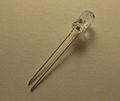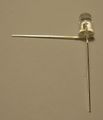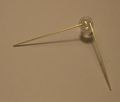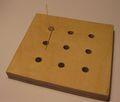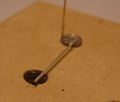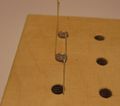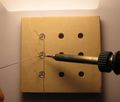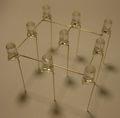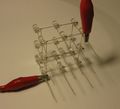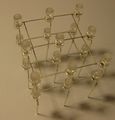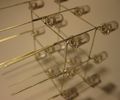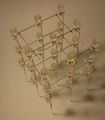LED Cube/Cube Lötanleitung: Unterschied zwischen den Versionen
(Die Seite wurde neu angelegt: „under construction {{Template:LED Cube Series}} This page of the LED Cube Series will guide you through the process of building the Cube structure of the LE…“) |
Keine Bearbeitungszusammenfassung |
||
| Zeile 1: | Zeile 1: | ||
{{Template:LED Cube Series}} | {{Template:LED Cube Series}} | ||
Diese Seite der [[LED Cube]]-Serie gibt Dir eine Anleitung, wie Du die Cubestruktur des LED-Cubes bauen kannst. Die Struktur zu bauen ist nicht sehr schwer, aber kann manchmal frustrieren sein, wenn die Drähte nicht so wollen wie Du. Das ist ganz normal und dein erster Cube wird wahrscheinlich nicht perfekt aussehen. Dafür ist dies ja auch ein Anfängerworkshop, es gibt einiges zu lernen. | |||
==LED | ==LED-Vorbereitung== | ||
How this first step will look somewhat depends on your LEDs. For now we will only clear LED bodies with one color: | How this first step will look somewhat depends on your LEDs. For now we will only clear LED bodies with one color: | ||
<gallery> | <gallery> | ||
Version vom 21. April 2012, 14:00 Uhr
Vorlage:LED Cube Series Diese Seite der LED Cube-Serie gibt Dir eine Anleitung, wie Du die Cubestruktur des LED-Cubes bauen kannst. Die Struktur zu bauen ist nicht sehr schwer, aber kann manchmal frustrieren sein, wenn die Drähte nicht so wollen wie Du. Das ist ganz normal und dein erster Cube wird wahrscheinlich nicht perfekt aussehen. Dafür ist dies ja auch ein Anfängerworkshop, es gibt einiges zu lernen.
LED-Vorbereitung
How this first step will look somewhat depends on your LEDs. For now we will only clear LED bodies with one color:
Thus, if you have matt LEDs, you do not have to care about this step.
The clear see-through LEDs have a big advantage over the matt ones: You can see through them and thus the illusion of free hanging lights is much better. However, they also have a notable disadvantage: They have a very small cone of light coming out at the top. This makes it nearly impossible to look into them from above, they nearly don't shine from the side and LEDs from below will also illuminate LEDs above them. A very good workaround at this point is to grab a sheet of fine sand paper and to sand the top surface of the LED. Here you can see the difference:
Repeat this step with all LEDs, if you want. Try not to bend the legs to much, as this will on one hand stress them and on the other hand make your cube look less regular. (Of course, you may want such a cube - that is your decision. ;) .)
LED Bending
In the second step we have to bend the legs of the LEDs so you can assemble them without much mechanical stress on the wires. Be careful with the next steps - they are deciding how your cube looks like. Also, try to bend the wires correct the first time and not wiggle much on them, they tend to break off if you overdo it.
Short Leg
First, take one LED:
Hold it upside down and make sure that the longer of the two legs is the left one, the shorter the right one. Then bend the shorter 90 degrees towards you. The result should look like this:
Repeat this step for all LEDs check twice that you bent the correct leg. If you are using the wrong ones, the LED will not work.
Long Leg
Again for all LEDs repeat the following steps: Take one LED and hold it like you did last time. This time, of course, the short leg is already bent to you. The long leg on the left side now is to be bent 90 degres to the left. The result will look like this:
Now take a pair of (flat nose) pliers and grab the same leg directly where the LED body ends:
And bend it back up. The long leg is now going into the same direction as prior to this step, but shifted away from the LED:
Don't forget to repeat this step for every LED:
Assembling the Planes
We have nearly finished preparing the LEDs. It is now time to assemble the planes. To get to the plane, we will first assemble a single row. A very handy tool for this is a plate with holes drilled into it where the LEDs belong.
Just insert the first LED into the top left corner of the plate, with the legs oriented like this:
Now cut the horizontal leg at the point where it has completely passed the adjacent hole:
Into the hole that is passed by the leg from the first LED, insert the next LED like this:
Again, cut the leg just after it passed the next hole:
Add the third LED like this and solder the legs together at the second and third LED:
The end result will look like this:
Now cut the leg of the lowest LED directly after the solder joint:
Repeat these steps to create the next two rows:
Take two pieces of (preferably silver-enameled copper) wire that are long enough to fit across the cube:
Solder all three joints of the three wires with the horizontal wires. Make sure these wires do not touch the vertical wires.
Cat away the any excess wire:
After you removed the construction from the plate you have the first plane ready. Carefully wiggle a bit on the long legs to check if all the solder joints are holding. If they don't, redo them.
Repeat this step for the next two planes so you have three planes before you continue.
Assembling the Cube
Now you should three have at least somewhat identical planes. The next step is obviously to join them to a cube. It is a good idea to fixiate two planes together, before trying to solder. We do this with alligator clips:
Make sure the planes are oriented the same way, if not, the LEDs will be shifted. Now just solder all nine joints. You may have to bend some wires a bit until they match:
Make sure you soldered all nine joints, especially the middle one. To fix this may be difficult, depending on your cube and tools available. You will get two nicely joined planes:
Now repeat this step for the third plane. Attach the second plane from below to the other two, otherwise soldering will not be easy.
That's nearly it! At least the hardest part is done.
Connecting the Cube to Your PCB
You should have already prepared the LED Cube PCB prior to the cube structure. If not, you probably want to do this now: LED Cube/PCB Soldering Manual.
If you are using connectors for the cube structure, go ahead and plug your cube into the nine column connectors. If you do not have connectors, still perform simply put the cube into the PCB and solder it. In both cases: It may be a good idea to take the orientation of this cube into consideration. One of the horizontal wires of the planes is most outside. You can tell this from this picture:
In this case, it is the side pointing away from you.
Try to get this side on the same side as the USB connector on the PCB. This will look like this:
@todo
Adding the Plane Connectors
Now we know how the cube is positioned on the PCB. The final soldering step is to add the connectors for the planes. If you remember - the wires that are currently holding the planes together are not yet connected to the PCB:
@todo pic
To fix this, get some (silver enameled copper) wire. Turn the LED cube, so you look directly onto the USB connector. Then cut one so it is at least long enough to reach from the PCB to the top plane.
@todo pics
Plug this piece of wire into the rightmost free connector of CONN12, if you are using connectors, or solder it into the PCB at the same place, if not. Bend the wire so that it touches the top plane and solder them together:
@todo pics
Repeat this step for the center pin of the connector and the plane in the middle and the leftmost pin of the connector and the bottom plane:
